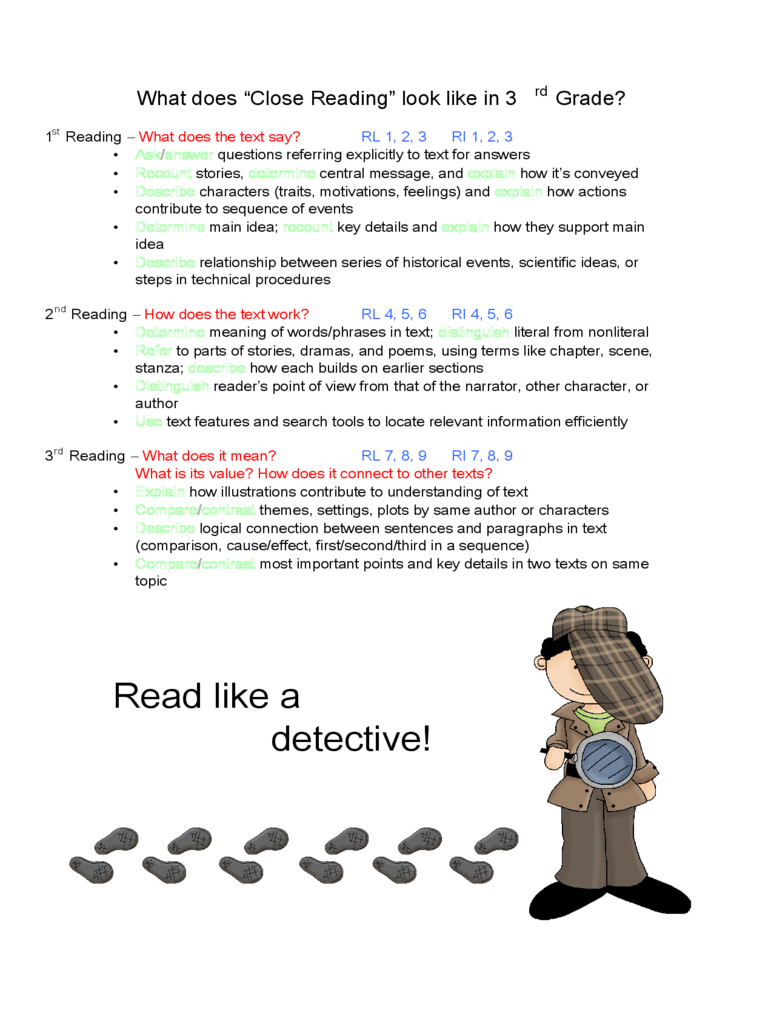Fillable Printable 3-5 Grade Close Reading Anchor Charts
Fillable Printable 3-5 Grade Close Reading Anchor Charts

3-5 Grade Close Reading Anchor Charts

What does “Close Reading” look like in 3
rd
Grade?
1
st
Reading – What does the text say? RL 1, 2, 3 RI 1, 2, 3
•
Ask/answer questions referring explicitly to text for answers
•
Recount stories, determine central message, and explain how it’s conveyed
•
Describe characters (traits, motivations, feelings) and explain how actions
contribute to sequence of events
•
Determine main idea; recount key details and explain how they support main
idea
•
Describe relationship between series of historical events, scientific ideas, or
steps in technical procedures
2
nd
Reading
–
How does the text work? RL 4, 5, 6 RI 4, 5, 6
•
Determine meaning of words/phrases in text; distinguish literal from nonliteral
•
Refer to parts of stories, dramas, and poems, using terms like chapter, scene,
stanza; describe how each builds on earlier sections
•
Distinguish reader’s point of view from that of the narrator, other character, or
author
•
Use text features and search tools to locate relevant information efficiently
3
rd
Reading – What does it mean? RL 7, 8, 9 RI 7, 8, 9
What is its value? How does it connect to other texts?
•
Explain how illustrations contribute to understanding of text
•
Compare/contrast themes, settings, plots by same author or characters
•
Describe logical connection between sentences and paragraphs in text
(comparison, cause/effect, first/second/third in a sequence)
•
Compare/contrast most important points and key details in two texts on same
topic
Read like a
detective!

What does “Close Reading” look like in 4
th
Grade?
1
st
Reading – What does the text say? RL 1, 2, 3 RI 1, 2, 3
•
Refer to details when explaining what the text says explicitly and when drawing
inferences
•
Determine a theme of a story, drama, or poem from details
•
Describe character, setting, or event drawing on specific details
•
Determine the main idea and explain how it is supported by key details
•
Summarize the text
•
Explain events, procedures, ideas, or concepts in a historical, scientific, or
technical text, including what happened and why, based on specific information
2
nd
Reading
–
How does the text work? RL 4, 5, 6 RI 4, 5, 6
•
Determine meaning of words and phrases, including those that allude to
significant characters found in mythology
•
Explain major differences between poems, drama, and prose
•
Refer to structural elements of poems/drama when writing/speaking
•
Compare/contrast point of view; know differences between first and third
person narrations
•
Determine the meaning of academic and domain specific words
•
Describe overall structure of a text
•
Compare/contrast a firsthand and secondhand account of the same
event/topic
3
rd
Reading
–
What does it mean? RL 7, 8, 9 RI 7, 8, 9
What is its value? How does it connect to other texts?
•
Make connections between text and visual/oral presentation of text
•
Compare/contrast treatment of themes, topics, patterns of events
•
Interpret information presented visually, orally, or quantitatively and explain
how it contributes to understanding text
•
Explain how authors use reasons/evidence to support points in text
•
Integrate information from two texts on same topic to write/speak knowledgeably
Read like a
detective!

What does “Close Reading” look like in 5
th
Grade?
1
st
Reading – What does the text say? RL 1, 2, 3 RI 1, 2, 3
•
Quote accurately from text when explaining what text says explicitly and when
drawing inferences from text
•
Determine theme of story, drama, or poem from details, including how character
respond to challenges
•
Compare/contrast two or more characters, setting, or events
•
Determine two or more main ideas of a text and explain with key details
•
Explain the relationships between two or more individuals, events, ideas or
concepts based on specific information
2
nd
Reading
–
How does the text work? RL 4, 5, 6 RI 4, 5, 6
•
Determine meaning of words and phrases, including figurative language
•
Explain how a series of chapters, scenes, or stanzas fits together to provide
structure of a story, drama, or poem
•
Describe how a narrator’s point of view influences how events are described
•
Determine the meaning of academic and domain specific words
•
Compare/contrast structure events, ideas, concepts in two or more texts
•
Analyze multiple accounts of same event noting similarities/differences in
point-of-view
3
rd
Reading – What does it mean? RL 7, 8, 9 RI 7, 8, 9
What is its value? How does it connect to other texts?
•
Analyze how visual elements contribute to meaning, tone, or beauty of text
•
Compare/contrast stories in same genre on approaches to similar
themes/topics
•
Draw on information from multiple sources; demonstrate ability to quickly
locate answer
•
Explain how authors use reasons/evidence to support points in text
•
Integrate info from several texts on same topic in order to respond
knowledgeably
Read like a
detective!



